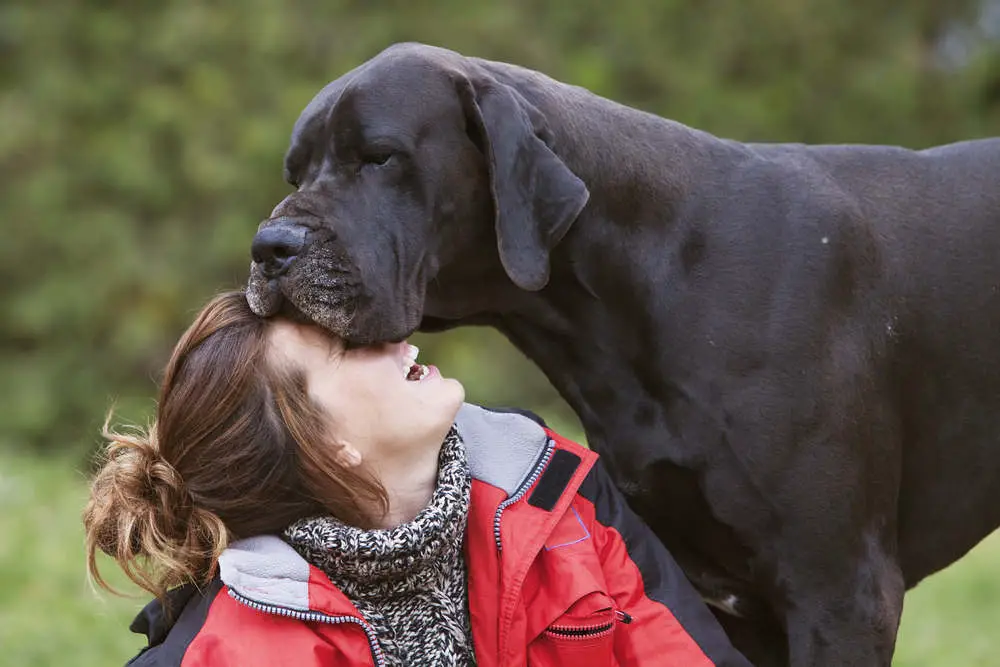
Also known as the “Apollo of Dogs”, Great Danes are gentle giants that are not only known for their size but are also popular for their sweet nature, protective, compassionate and confident personality and love for companionship. This breed is extremely friendly, protective and just loves people’s company and gets extremely attached to their owners.
Just like human beings, dogs also develop close bonds with those they love. They are extremely social and need constant interaction. Also called “Velcro Dogs”, Great Danes crave attention and are happiest when they are amidst people.
These dogs don’t do too well when left alone for prolonged periods and can even develop separation anxiety. Proper socialization and training can prevent your pet from panicking every time you leave him alone and wreak havoc in your home.
Signs of a “Velcro Dog”
Typically, a dog is described as a “Velcro Dog” when they display clingy and overly dependent behavior and some of the signs of a Velcro dog include:
- Following you around everywhere, from one room to another in your home.
- Keeping you in their line of sight all the time.
- Trying to sit as close to you as possible and climb onto your lap.
- Anticipating when you’re going out or leaving the room.
Why Your Great Dane May Get Attached to a Single Person
Like any other dog breed, while your Great Dane loves all the members of his human family, over time, he may start developing a special bond with one person, whom he perceives as his leader and caretaker.
Great Danes are pack animals and depend on their alpha for their survival. So, this behavior of getting attached to a single person arises mainly from the pack animal behavior and alpha syndrome, where your pet declares his commitment to one person in the family.
Your pet may feel an instinctive kinship with the chosen master with whom he feels secure and relaxed around. And, this bond may be strengthened, especially if you are your pet’s primary caretaker and groom him, exercise and play with him, give him treats, spend plenty of time with him and give him plenty of love. This makes your pet develop a special bond with you because he associates all the good and positive things with you.
Your Great Dane is likely to convey his special affection to his chosen human by curling up next to them, cheering them up when they seem sad or sick, wanting to play with them and always hankering for their attention and cuddles.
It’s a wonderful feeling to have your Great Dane waiting for you eagerly and following you around. And, while this may seem quite cute at the start, this behavior can get tiring and annoying over time and his over-dependence can become rather frustrating and overwhelming, especially if your pet becomes overly protective of you.
Your Dane may perceive any new person or animal as a threat and growl and bark every time you go out or anyone comes close to you. And, you must take steps to curb this overprotective behavior of your Great Dane right at the start, otherwise, every time you meet someone or leave your pet alone, he will get stressed and, as mentioned earlier, develop acute separation anxiety.
However, having said that, you must keep in mind that although your Great Dane shows signs of being clingy and likes to be around you 24×7, he may not develop separation anxiety. Nevertheless, if he does show signs of developing separation anxiety, in the next section, we’ll discuss some tips on how you can prevent this.
Also Read: 21 of the Best Great Dane Mix Breeds
How to Reduce Your Great Dane’s Separation Anxiety
Here are some tips and techniques that you can follow to reduce your Great Dane’s dependence on you and also prevent separation anxiety.
- Train your pet to be more independent by reducing the amount you spend with him. If you’re available for him all the time, then even a very short absence can make your pet stressed.
- While your Great Dane does not require a lot of exercise, they are still athletic and active dogs. Ensure that your Great Dane gets sufficient and regular exercise, which can help to tire out and calm your pet.
- Encourage your pet to socialize with other dogs and pets.
- Encourage your pet to interact and play with other members of the family and encourage them to take your pet for walks, bathe him, groom him and get involved in his daily activities.
- Providing your Great Dane sufficient physical and mental stimulation can help to strengthen his positive experiences and strengthen your bond.
If your Great Dane experiences mild separation anxiety, it can be resolved by exercise and training; however, in moderate to extreme cases, you may have to get professional medical help. Your vet may prescribe some medications, which can help to reduce your pet’s stress, anxiety and calm him down.
Also Read: Are Great Danes Loyal to Their Owners?
Parting Thoughts
In conclusion, your majestic, royal and well-behaved Great Dane is a gentle, emotional pooch, who thrives on human companionship and loads of love and attention. It is but natural that your pet is likely to love the person who is around him at all times and takes care of all his needs.
However, if you don’t want your pet to become overly clingy and dependent on you or any other person, then you must ensure that he is socialized and trained at the earliest, which can help to manage his behavior.
